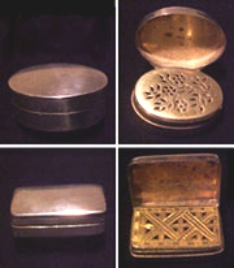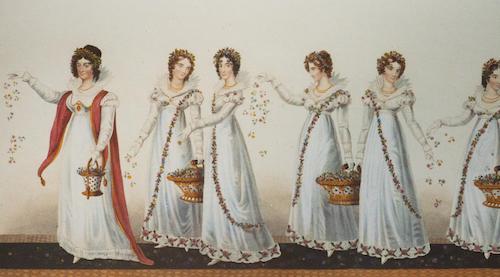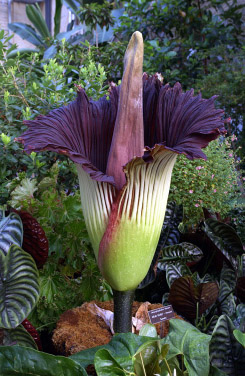Smell the Roses — A Science of Fragrance
by Ray Novitske, Fairfax Master Gardener

Hybrid tea rose
Spring is in the air and our noses can smell it. The sweet-smelling blooms remind us that plants also enjoy the warming weather, often for other reasons than we do. Science, evolution and Mother Nature are behind this.
Humans detect scents in small quantities. Smell is a reaction of certain cells in our nose to volatile chemical compounds emitted by essential oils in plant parts. The oils may come from roots, stems, leaves (think herbs) or most commonly, sweet-smelling flowers.

Antique vinaigrettes
History
Fragrance in human history was more important to humans than it is today. Going back to Mesopotamia and Egypt, perfumes and oils were used in religious ceremonies and to help mask the bad odors more common then. Remember frankincense and myrrh? They were valuable commodities of oils and resins that came from a tree and a shrub. Frankincense has been studied and found to affect mouse brains and exhibits depression and anxiety dampening effects. King Tut was buried with frankincense pellets and gum resins, reserved for royalty because of their value and rarity.
As bathing declined during the European Middle Ages, the use of fragrant herbs became more popular. Strewing herbs were laid along the floor so that pleasant odors would be released when people walked on them and crushed them. Some repelled nasty insects, too. You might remember images of people scattering plant leaves along a path for others to trample on. Mints, cedars, scented geraniums, rosemary, chamomile and lavender were most widely used for strewing herbs.

Women strewing herbs
Pouncet boxes and vinaigrettes were small decorative perforated cases that held small materials soaked with alcohol or vinegar based fragrances. They were worn and were inhaled for medicinal purposes, and sometimes for defending against unpleasant odors encountered on smelly city streets. Victorians valued scented plants, particularly in a “grandma’s garden.” They understood that fragrances are evocative of emotions and memory. It turns out that in the brain’s anatomy, smell, memory and emotion are closely linked.
Science
Our smell and taste receptors are chemical detectors. For example, snakes and some animals use their tongues to smell, essentially detecting chemicals in the air. Our smell and taste are directly related because they both use the same types of receptors and are processed in similar parts of the brain. If one’s sense of smell is not functional, then the sense of taste will also be affected because of the relationship of the receptors.
Because these fragrant oils and compounds evaporate easily in warm weather, they are called volatile compounds. We smell only short molecules — those that are small and light enough to float in the air. Larger ones are not volatile and heavier and are not suspended in the air easily. We call them essential oils in the sense that they contain the “essence” of a plant’s fragrance. They are usually of oily consistency and feel, so are called oils, as opposed to a fatty oil that does not evaporate when exposed to the air.
Flowers
Plants use scent in two ways. They use it as a method to attract pollinators, or to repel pests. Fragrant blooms attract insects, bats and hummingbird pollinators that through their actions with a flower, transfer pollen to plants and create fertile seeds. Different pollinators, however, have different visual detection systems. Some are good at distinguishing reds, oranges and yellows, while others are not. Some are most active at night, and others during the day. As a result, plants have developed different systems to attract the type of pollinators they need.
The red, orange and yellow flowering plants are colored to attract the pollinating insects and birds that respond to these colors, so scent is not as important. Flowers colored with these hues generally have less fragrance. The lighter colors of pink, whites and lavenders are found to have a pleasant but still faint fragrance, relying on both color and fragrance to attract their preferred pollinators who may not be adept as detecting the more vibrant colors.

Moth pollinator of fragrant night-blooming datura
Then there are white flowers. Many are moth-pollinated flowers and produce scents only at night or early evening when moths and night pollinators are out. Their white colors are easier to distinguish for these pollinators in the dark than vibrant red colors are. And, because these pollinators don’t see as well in the limited light, scent becomes an important method for plants to attract them. Many moth-pollinated flowers are white and only produce scents at night. I am thinking of my white night-blooming moonflowers and datura.
And of course, self-pollinating plants have no fragrance because there is no need to attract pollinators.

Corpse flower, Amorphophallus titanum
Production of volatile oils in flowers takes a good amount of energy. Like flowers, their sole purpose is to attract pollinators. For many flowers like a rose, fragrance occurs when conditions are right for peak pollination. Newly opened blossoms don’t produce as much scent as mature blossoms, because the early blooms are not ready to be pollinated yet, so the lack of scent makes them less attractive to pollinators. In many flowers, a special enzyme is produced once the bloom is pollinated. Once fertilization has occurred, the enzyme shuts down the plant’s production of the compounds, since they are no longer needed.
In addition to fertilization, environmental factors will also affect a flower’s fragrance. For example, a rose’s fragrance is strongest on warm sunny days when the soil is moist — optimal conditions for insect pollinators to be out and to manufacture the essential oils. The warmth also aids in the light volatile oils being released into the air. Humidity affects the fragrance too because humid air is heavier and reduces the rate of chemical evaporation.
Not all flowers are pleasant to us. Consider the corpse flower with its smell of rotten meat to attract its pollinator flies. Queen Anne’s Lace and daisies produce an unpleasant smell because these odors attract the flies they prefer for pollination.
Herbs
Scents can be found in different parts of the plant in addition to flowers. Minty sharp smells in foliage of certain plants play a defensive role by containing chemicals that are toxic or unpleasant and thus repelling animals or insects. In small quantities, we find them as great additions for flavoring our food.
These oils can also protect against disease. Cinnamon oil kills typhoid germs in a quick 12 minutes. Other essential plant oils have similar properties in preventing bacteria and viruses from taking hold in them. Attar, an essential oil found in roses, has a great antiseptic property. Oil of thyme and oregano contain carvacrols, great antimicrobial chemicals that are not only useful to the plants, but work for humans, too.
Where to Plant
Plant those fragrant flowering plants around walkways and near the home, surrounded by sheltering shrubs, trees and fences. Avoid placing them in windy or open locations to keep their scents from dissipating. Plants with fragrant foliage need to be bruised or crushed to release their scent, so plant along walkways in areas where they can be brushed against or stepped on.
Fragrance is rare in most plants — most have none. So plant some that do and attract some pollinators and enjoy their scent at the same time.
References
• Fragrant plants can be pleasant to your sense of smell and attract pollinators, Josh Fuder, University
of Georgia Cooperative Extension
• Understanding of floral scents blossoms, Purdue News, Purdue University
• Those fragrances you enjoy? Dinosaurs liked them first, Oregon State University
• New study reveals flower color, fragrance coordination, Cornell Chronicle, Cornell University